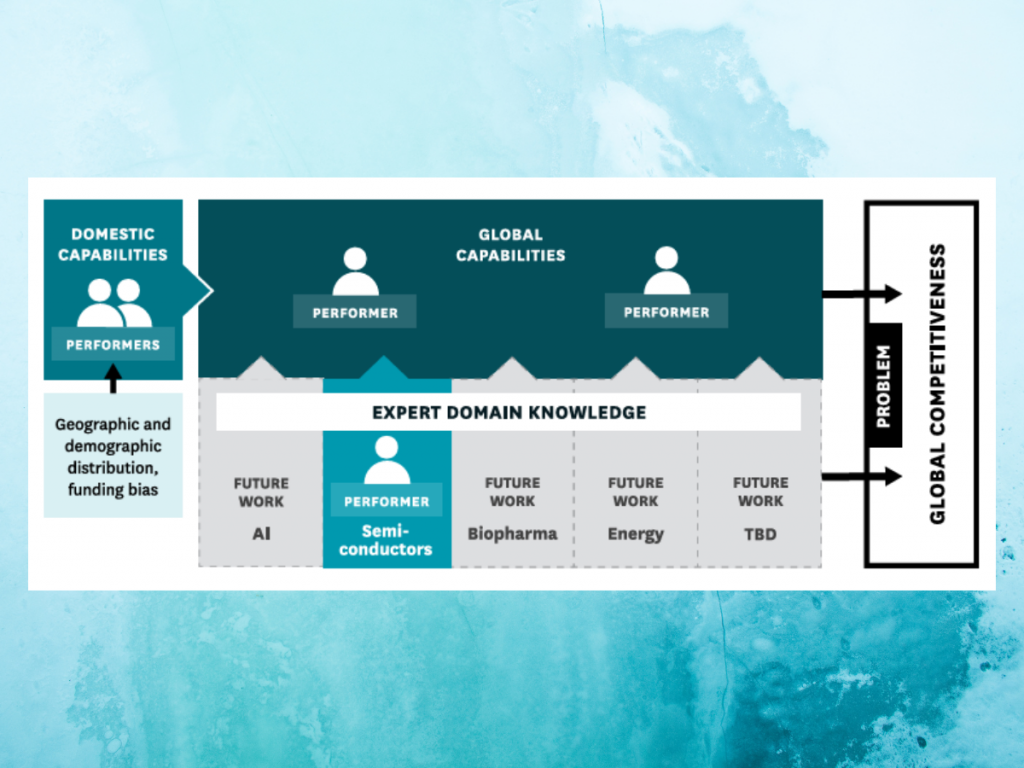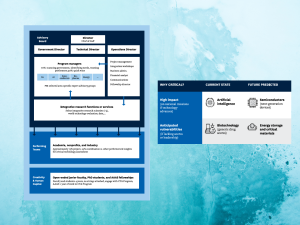This article is part of PSF’s Exec Summaries series where we take prominent reports in emerging technology and provide digestible summaries.
Overview of Report on Critical Emerging Technology Assessments
In Securing America’s Future: A Framework for Critical Technology Assessment, the National Network for Critical Technology Assessment (NNCTA):
- Offers a comprehensive framework for evaluating critical emerging technologies in the U.S.
- Addresses the need for integrated national technology strategies
- Articulates the role of data and analytics in shaping policy and strategic actions.
The report is structured into chapters that cover U.S. capabilities in emerging technology assessment as they relate to national objectives, and demonstrates the use of analytics in informing national technology strategies.
The final report emphasizes interdisciplinary collaboration and innovative approaches for a robust CTA framework, focusing on areas like global competitiveness, artificial intelligence, semiconductors, biopharmaceuticals, and energy. The report culminates in a vision for the future and the necessary steps to achieve this vision, considering the challenges and gaps in the current approach.
Full recommendations are provided at the end of this summary.
What is the mission of the NNCTA?
The mission of the National Science Foundation’s (NSF) Technology Innovations and Partnership-funded pilot NNCTA is to establish a comprehensive framework for evaluating critical technologies crucial for U.S. competitiveness and security. The goals include integrating diverse data and analytical methods to inform national technology strategies, fostering collaboration across disciplines, and enhancing the U.S.’s ability to respond to technological advancements and challenges.
The mandate involves developing innovative approaches for Critical Technology Assessment (CTA), emphasizing the role of data-driven insights in shaping policy and strategic decisions.
The NNCTA recommends a multi-faceted approach for critical technology assessments
The overarching recommendation of the report is a multi-faceted approach for critical technology assessments, focusing on (1) integrating diverse data sources, (2) leveraging interdisciplinary expertise, and (3) utilizing advanced analytical tools. This approach emphasizes the need for adaptability in rapidly changing technological environments and seeks to inform strategic decisions for U.S. national interests in technology.
In Chapter 3, the NNCTA proposes a formalized CTA discipline which it describes as a framework to provide comprehensive evaluations of critical technologies that are vital for U.S. national interests. The primary goals and objectives of this CTA discipline are to assess the potential impact of these technologies on national security and competitiveness, foster interdisciplinary collaboration, and develop innovative methodologies for effective technology strategy and policy formulation.

The CTA discipline aims to integrate diverse data and analytical approaches to better inform decisions on national technology strategies. It is designed to be adaptive and capable of responding to the rapidly evolving technological landscape, and focuses on providing actionable insights for policy and strategic decision-making. With broad adoption, the CTA program has significant potential to create a robust framework for evaluating the impact and potential of emerging and critical technologies.
Ref: pgs 13-19
Pilot Year Activities Focused on Demonstrating Value of Analytics in Informing a National Technology Strategy
The report represents the culmination of NNCTA’s pilot year, during which the CTA program was conducted and assessed with the purpose of demonstrating how analytics can inform a national technology strategy. The origins and background of the report are rooted in recognizing the need for a comprehensive approach to evaluating critical technologies vital for U.S. national interests. This need led to the establishment of the NNCTA, focusing on developing tools and methods to inform U.S. National Technology Strategy for security, prosperity, and social well-being.
Key activities and efforts conducting during this pilot year, as outlined in Chapter 4, included:
- Conducting research projects demonstrating current and prospective analytic capabilities for critical technology assessment.
- Prototyping structured workshops with experts from various sectors to discuss specific policy problems and analytics.
- Leveraging these workshops for consensus-building and developing intellectual foundations for CTA.
- Developing a review process to inform policy recommendations based on a broad base of analytic activities.
- Key findings emphasized the need for rapid, interdisciplinary approaches in technology assessment and the importance of integrating diverse data and analytical methods for effective national technology strategy development.
Analytic Pilots focused on a Few Key Emerging Technology Areas
The CTA’s pilot year demonstrated how analytics can inform national technology strategy through several area demonstrations:
- Global Competitiveness: Emphasizes leveraging analytics to understand and improve the U.S.’s position in the global technology market. Ref: pg 24
- Artificial Intelligence: Focuses on AI’s role in enhancing various sectors, necessitating strategic investments and policy. Ref: pg 40
- Semiconductors: Highlights the strategic importance of semiconductor technology and the need for a robust supply chain. Ref: pg 52
- Biopharmaceuticals: Addresses the advancements in biotech and their implications for healthcare and biodefense. Ref: pg 60
- Energy and Critical Materials: Discusses sustainable energy technologies and the management of critical materials essential for technological development. Ref: pg 70
The cross-cutting lessons from the five pilot areas, as described in Chapter 5 (pgs 80-90) underscore the:
- Importance of integrating diverse data and perspectives
- Need for adaptability in methodologies to match the pace of technological changes
- Value of interdisciplinary approaches in assessing and strategizing for critical technologies.
These lessons highlight the complexities and interconnected nature of modern technology, emphasizing the significance of a comprehensive, collaborative approach for effective national technology strategy.

Many Challenges Exist for Critical Technology Assessments of Emerging Technologies
During its pilot year, the NNCTA encountered several challenges in assessing emerging technologies. These include:
- Rapid Pace of Technological Advancements: The fast pace of technological change makes it difficult to keep assessments current and relevant.
- Complexity and Interconnectedness: Technologies are increasingly complex and interconnected, complicating assessment processes.
- Data Limitations: Access to reliable and comprehensive data for assessment is often limited.
- Multidisciplinary Nature: Effective assessment requires integrating insights from multiple disciplines, which is inherently challenging.
- Global Context: The global nature of technology development and deployment adds another layer of complexity to assessments.
These challenges underscored the difficulty in accurately evaluating the potential impact and development trajectories of emerging technologies, which are critical for U.S. national security and competitiveness.
Ref: pages 100-103
Recommendations and Conclusions Presented In This Report
In the concluding Chapter 7 (pgs 100-103), the report outlines key future needs, gaps, and challenges in CTA, emphasizing the necessity for advanced, adaptable methodologies to keep pace with rapid technological changes. It highlights the need for more comprehensive data collection, enhanced interdisciplinary collaboration, and the integration of diverse analytical tools. Addressing these challenges is crucial for effectively assessing technologies that are vital for national security and competitiveness.
The main recommendations and conclusions of the report emphasize the need for:
- Enhanced interdisciplinary collaboration in technology assessment.
- Development of robust, data-driven methodologies for evaluating critical technologies.
- Strengthening U.S. capabilities in technology assessment to maintain global competitiveness.
- Fostering innovation and bridging gaps in current strategies.
- The report concludes with a call for comprehensive, strategic actions to address these recommendations, highlighting the importance of an integrated approach for the future of technology assessment in the U.S.
This report targes policymakers, technology strategists, and industry leaders concerned with U.S. competitiveness and security in the technology sector. For those interested in this area, the recommended actions include engaging in interdisciplinary collaboration, utilizing data-driven approaches for technology assessment, and actively participating in shaping national technology strategies. Implementing the report’s recommendations can help stakeholders stay ahead in the rapidly evolving technological landscape, ensuring informed decision-making for national benefit.